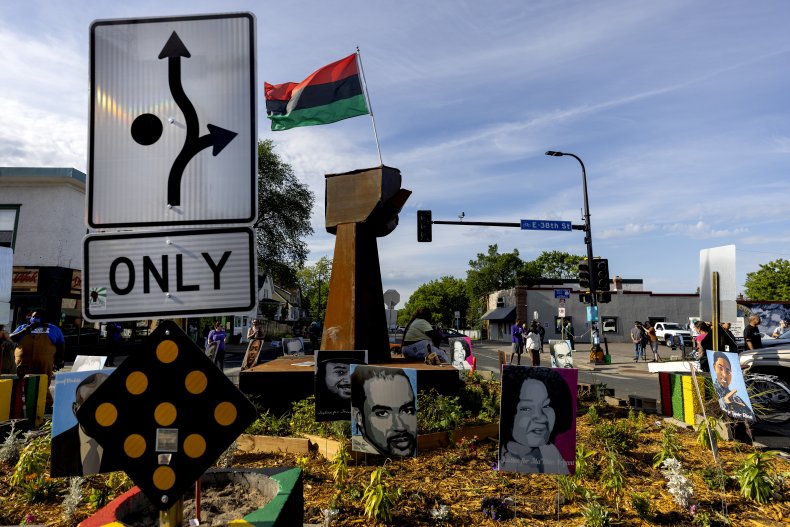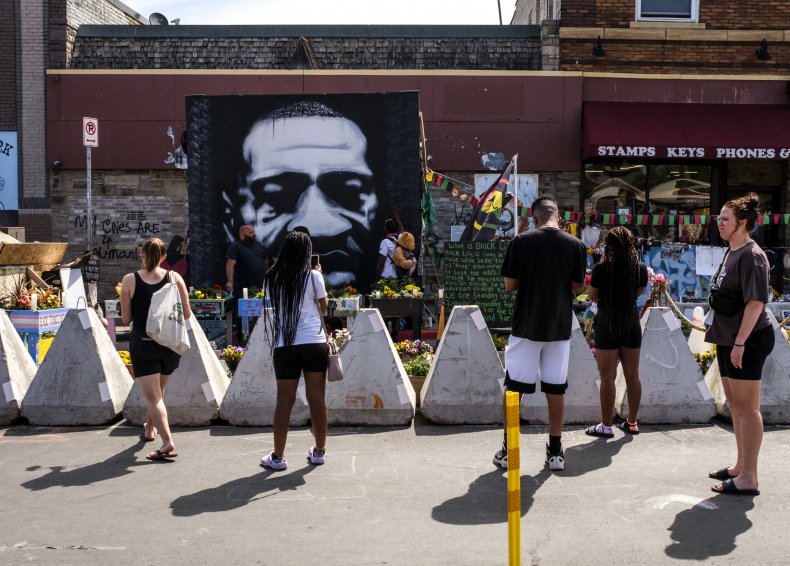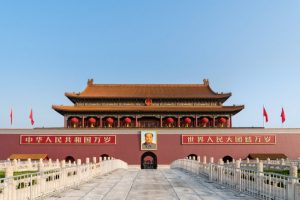After Minneapolis city officials cleared a memorial to George Floyd and removed the concrete barriers blocking traffic, activists set up makeshift replacements to continue their demonstrations to honor Floyd and the racial justice movement.
The site, known informally as George Floyd Square, sprang up organically in the days after Floyd’s death as people gathered to grieve. Eventually, artwork, flowers and other items were placed at the intersection of 38th street and Chicago Avenue where Floyd was killed at the hands of police officers last year.
Jaylani Hussein, executive director of the Minnesota chapter of the Council on American-Islamic Relations, said that the removal of the memorial was an attack on Floyd’s legacy.
“This space is a space that has now become a national memorial, a national memorial for victims of police violence all over this world,” Hussein said during a news conference.
“We will not give up this space,” he said. “We will save it for George Floyd.”
For more reporting from the Associated Press, see below:
Stephen Maturen/Getty Images
The community group Agape coordinated the clearing of the intersection, according to city spokeswoman Sarah McKenzie. A fist sculpture, which stands several feet tall, will remain, McKenzie said.
The intersection had been closed to traffic since Floyd’s death on May 25, 2020, but some residents were starting to express frustration that it had been closed to private and transit vehicles for so long.
Traffic briefly flowed through the intersection Thursday morning after the concrete barriers were removed, but community members quickly erected new makeshift barriers. Dozens of people gathered near the intersection, singing, chanting Floyd’s name and giving speeches expressing frustration and urging people to continue organizing.
Mayor Jacob Frey and other city leaders pledged to reopen the intersection, but residents and activists who served as unofficial leaders and organizers at the square said they wouldn’t step aside unless the city met their list of 24 demands.
Among them: recall the county prosecutor, fire the head of the state’s criminal investigative agency, and spend hundreds of thousands of dollars on programs to create jobs, combat racism and support affordable housing.
The city cited business losses in the area as one reason to reopen the intersection. Violent crime at the intersection and the blocks immediately surrounding it also rose dramatically in 2020, though crime also increased citywide. There were 19 nonfatal and fatal shootings in the area in 2020, including 14 from May 1 through August 31. That’s compared with three shootings in all of 2019 and none during the summer months.
Shots were fired in the area last week, just hours before an event to mark the anniversary of Floyd’s death. One person was injured.
Steve Floyd, one of Agape’s founders, said the group coordinated with the city to remove the barriers, garbage cans and portable toilets starting at 4:30 a.m.
Floyd, who is not related to George Floyd, said he admires the demonstrators’ efforts to maintain the square but that they had to engage the city in that process “instead of letting them come in here with bulldozers.”
“As far as controlling this and maintaining it, that’s a noble job. We don’t disrespect the protesters, everything can stay the same,” he said. “They can still do it. But we just let them in here to fix what we have and develop it.”
Frey, City Council Vice President Andrea Jenkins and City Council member Alondra Cano issued a statement after the crews initially cleared the intersection.
“The City’s three guiding principles for the reconnection of 38th and Chicago have been community safety, racial healing and economic stability and development for Black, Indigenous, Latinx, Asian and other communities of color,” they said, adding that a permanent memorial would be established and the artwork preserved.
Former Minneapolis police Officer Derek Chauvin was convicted in April of second-degree unintentional murder, third-degree murder and second-degree manslaughter for pressing his knee against Floyd’s neck for about 9 1/2 minutes as he pleaded for air while handcuffed face down on the street.
Chauvin has also been indicted on federal charges alleging he violated Floyd’s civil rights, as well as the civil rights of a 14-year-old he restrained in a 2017 arrest.
The three other former Minneapolis police officers involved in Floyd’s arrest and death were also charged with federal civil rights violations. They await trial in state court on aiding and abetting counts.

Carlos Gonzalez/Star Tribune via AP



















